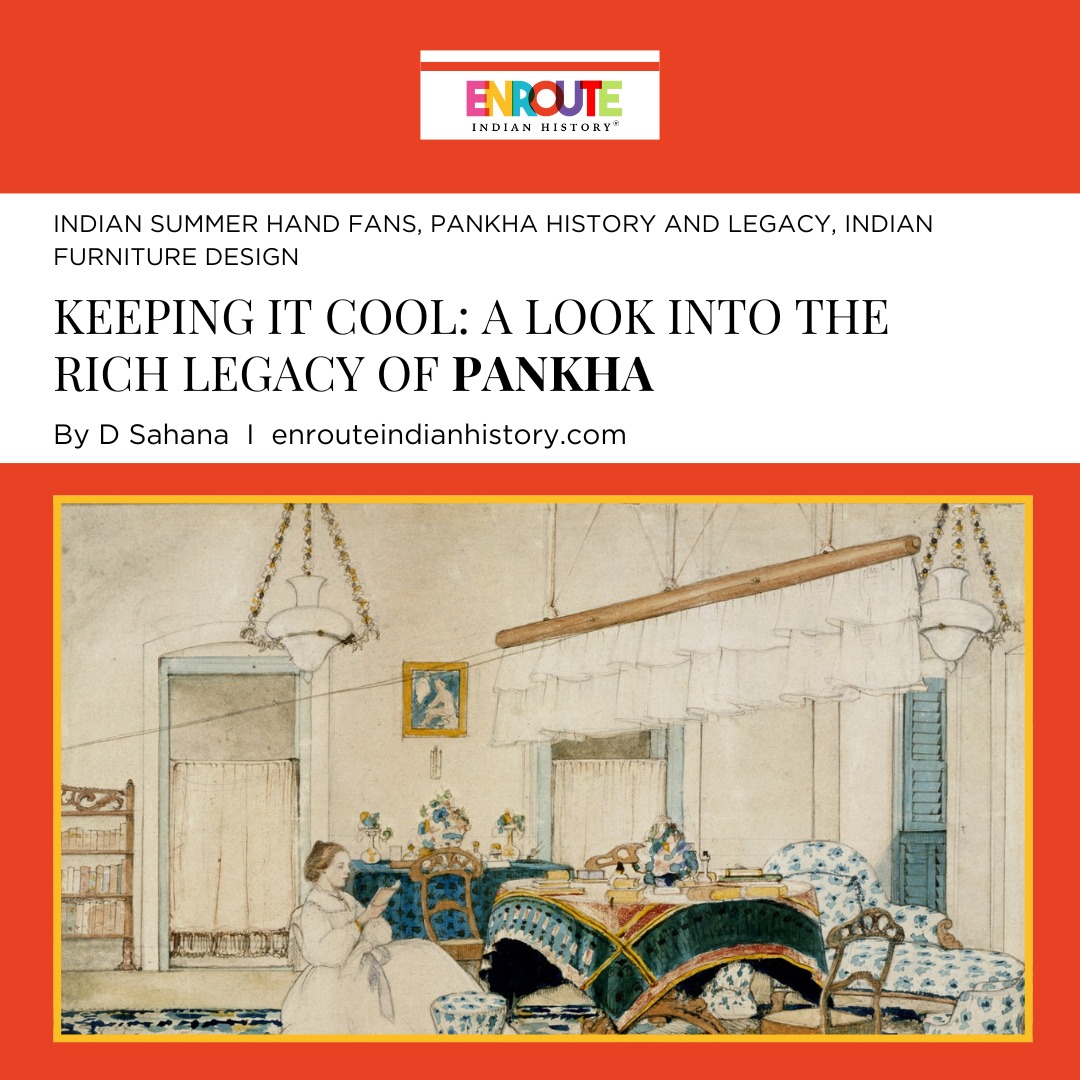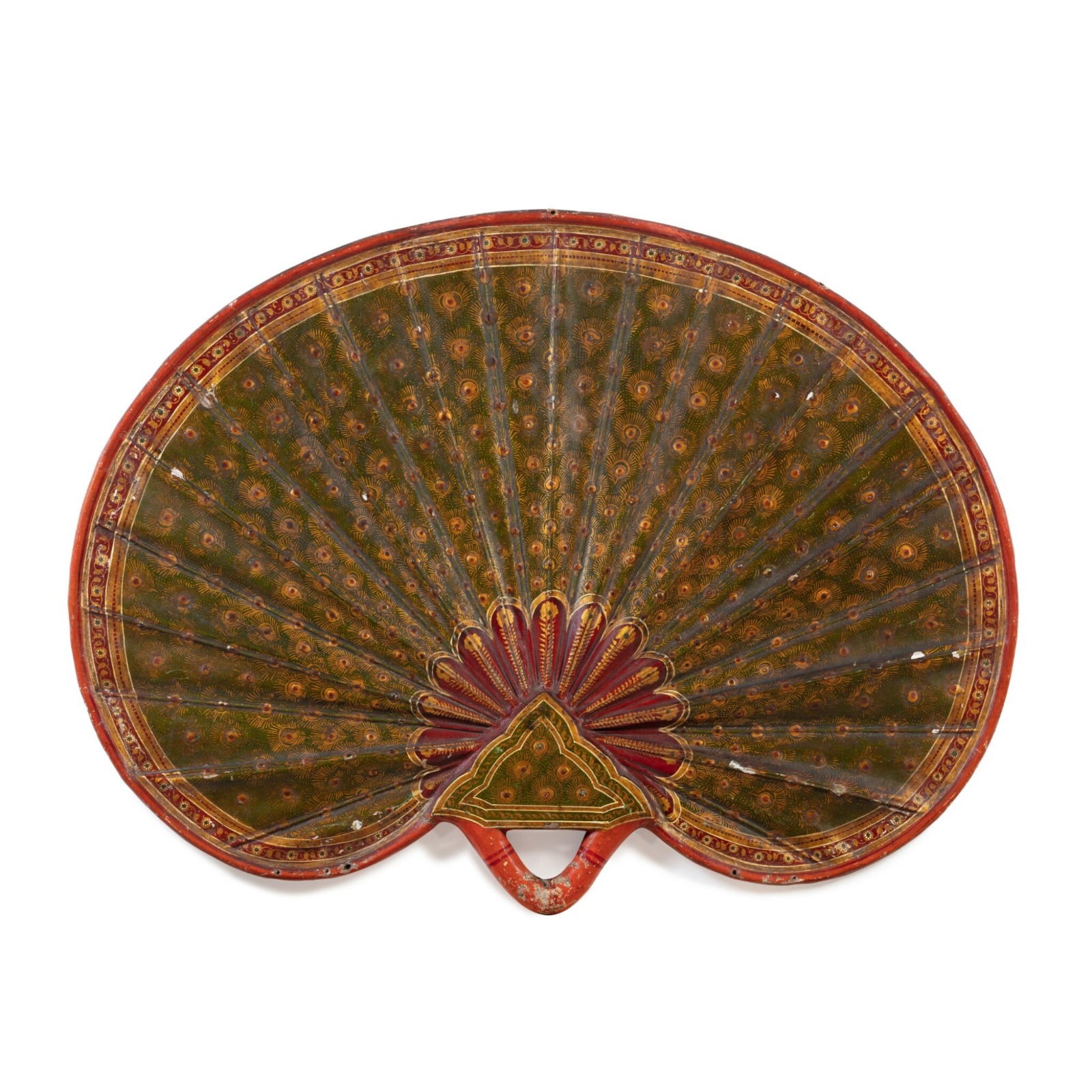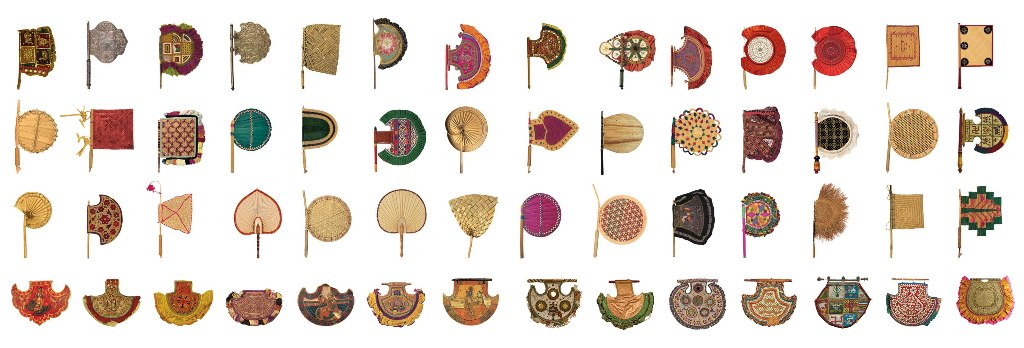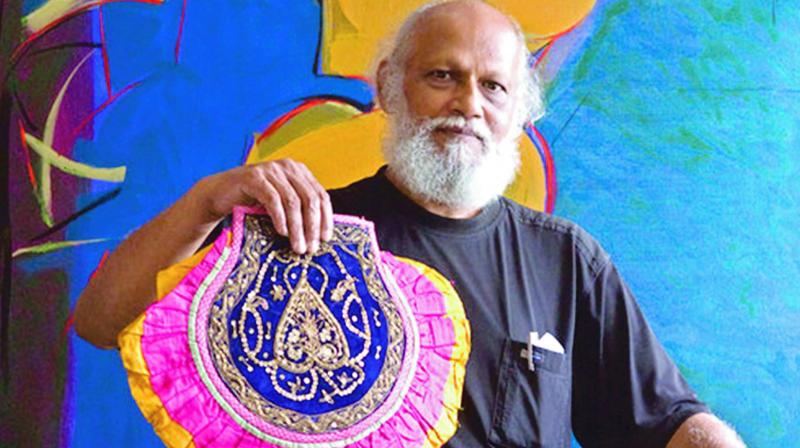
In summer, especially in India, people engage in various activities, such as visiting hill stations, swimming, making traditional Indian pickles, eating fruits such as mangoes, etc. However, a small object we all have been familiar with also sees an appearance; however, it is mainly ignored due to its nature and simplicity. However, it impacts our lives, and that is the pankha. Pankha, or punkah, refers to a traditional fan. It can also be a hand fan or even a ceiling fan. Despite being such a simple and utilitarian object, it has a vast and rich cultural legacy in the subcontinent. It is not just an object to cool oneself; it is much more than that.

Pankha from 19-20th century Madras
(source:https://www.sothebys.com/en/buy/auction/2021/arts-of-the-islamic-world-india-including-fine-rugs-and-carpets-2/two-fans-pankha-india-madras-19th-20th-century)
Despite being a practical object, it is still a top-rated product, especially during summer. Regardless of being in a modern world surrounded by electric fans, this pankha comes to our rescue when the electricity goes off. The word punkha or pankha originates from ‘pankh’, which means feathers of a bird. Pankha is now a term for fans; earlier, it referred to a small hand-held fan. Pankhas have been prevalent since ancient times. One can see the existence and usage of pankhi (as it was called earlier) in Buddhist wall paintings in Ajanta and many sculptures elsewhere.

Female figure with a hand-fan, Kausambi, Uttar Pradesh, 1st century BCE (Source: Wiki Commons)
PUNKAH AND THE BRITISH

A woman reading under a punkah (Source: Wiki Commons)
Pankhas vary in size, material, and design; some are made with bamboo and cane, some with reed, and others use silk, satin or even paint. When it comes to design, these pankhas can be simple with just some colour or are beaded and have mirrors. One might usually associate pankha with hand fans, but there is also another type of pankha; they were ceiling fans. These fans were giant, attached to the ceiling, and pulled by “Pankha-wallah”, which cooled the room. It is seen that this type of pankha was very much prevalent in British homes in India. Ritam Sengupta writes that there was an underlying relationship between the master(colonial lord) and the servant(the punkahwallah) on the lines of the servants’ “labouring time”, and there were regulations around not just labour but also the kind of labour to hire. He mentions that a large group of primarily male servants filled up these seasonally available positions in regions of British India of being a punkahwallah.
PUNKAHS IN ART AND AESTHETICS

Collection of fans from Jatin Das’s collection
(Source: https://www.jdcentreofart.org/pankha)
As mentioned above, pankhas were of varying designs and shapes, and these variations contributed to the rich cultural legacy of the subcontinent. One such incident of the celebration of these fans was in 2004 when the Fan Museum in Greenwich, London, showcased an exhibition titled “Pankha: Traditional Crafted Hand Fans Of The Indian Subcontinent”. This exhibition showcased over 100 traditional hand-crafted fans. Apart from highlighting the uniqueness of Indian fans from their East Asian counterparts and the creative liberties each region took in fans’ design and approach, this exhibit also highlighted that the traditional fans were not just products made by the artisans but also by women who stayed at home and also focused on the decline of this traditional craft.

Jatin Das with a fan from his collection
(Source: https://www.deccanchronicle.com/lifestyle/books-and-art/060618/fanning-an-old-art.html)
A recent exhibit on Pankha was done by Jatin Das at the Indira Gandhi National Centre for the Arts in 2018. The exhibit titled “PANKHA: A Collection of Hand Fans from the Indian Subcontinent and Beyond” showcased over 5,000 fans from the personal collection of the artist Jatin Das. This collection began when his friend gifted him a fan a few decades ago. According to Jatin Das, pankhas represent culture, story and origin.
PANKHA AND POSTAGE

Stamps from the 2017 collection (Source: Wiki Commons)
In 2017, the Indian Postal Department released 16 postage stamps featuring different styles of Indian hand fans. These stamps featured fans from various states. Some styles include the Applique Hand fan from Rajasthan, which uses ornamental needlework. Some other fans from Rajasthan included the zardozi fan, which has gold threadwork, painted hand fans, and satin ceiling fans. Fans from Gujarat were the mirror work fans as well as leather fans. Leather hand fans are from Kutch, Gujarat, where the leather is hand-stitched into its desired shape and is further decorated with threads or wool on its seams. Fans from Uttar Pradesh, West Bengal, and Orissa were also featured in these stamps.
However, some of the most exciting stamps were the Sola Pith Hand Fan from West Bengal and the Temple Hand Fan from Rajasthan. These hand fans are made of milky-white sponge wood from the Sola tree, a bean family plant generally found in marshy, waterlogged areas. Sola pith and reed hand fans are used for Devi worship and are very delicate. Another interesting fan featured was the Temple Hand Fan from Rajasthan. These fans are generally engraved brass hand fans with long handles and are offered to the temple deity in Rajasthan.
Hence, even though hand fans are usually associated with Chinese or Japanese folding hand fans, their Indian counterpart, the pankha, is equally alluring. Fans are not just objects that help keep oneself cool; they also reveal one’s social status, especially when it comes to ceiling fans. Pankhas were also products with an audience ranging from royals to the commoners, and each of their pankhas had its uniqueness; the royals had elaborate and intricate designs, while the commoners had a more humble design. Regardless, pankha is a product of the rich cultural practices of India, and it is one of the tangible artefacts that is slowly declining in the world. The Pankha shows us the artists’ artistry and creativity and makes us realise that many artisans and craftsmen are vulnerable to the fast-paced world where traditional handicrafts are nowhere to be seen. Even though these crafts are celebrated in art, postage, etc., However, preserving such artistry is essential to retain this rich, tangible culture.
REFERENCES:
Sengupta, R. (2021) ‘Keeping the master cool, every day, all day: Punkah-pulling in colonial India,’ Indian Economic and Social History Review, 59(1), pp. 37–73. https://doi.org/10.1177/00194646211064592.
Sushmit (2022) The Allure of the cool breeze: The story of Hand Fans. https://livingwithart.blog/2022/08/26/the-allure-of-the-cool-breeze-the-story-of-hand-fans/.
Indian Hand Fan (2017). https://www.istampgallery.com/indian-hand-fan/#:~:text=The%20History%20of%20Indian%20Hand,a%20person%20to%20move%20them.
Gaatha_Home (2024) Winds of Change ~ Indian hand Fan (Pankha). https://gaatha.com/indian-hand-fan-pankha/.
Saklani, J. (2018) ‘The modest hand fan takes centre stage at artist Jatin Das’ ‘Pankha,’’ The Hindu, 16 June. https://web.archive.org/web/20211116200310/https://www.thehindu.com/society/fanning-memory-desire-pankha-a-collection-of-hand-fans-from-the-indian-subcontinent-and-beyond-by-artist-jatin-das/article24171388.ece.
















